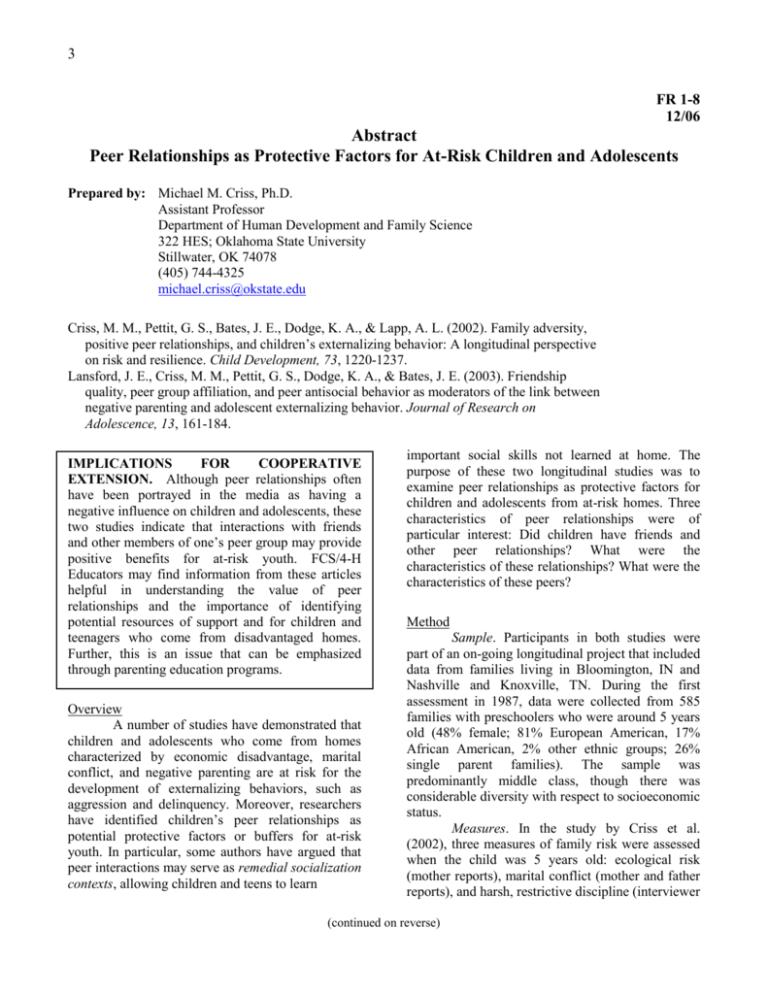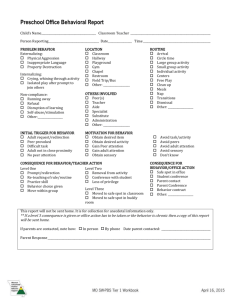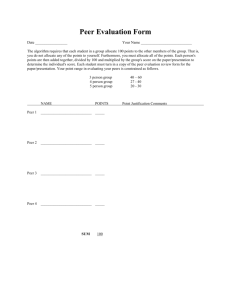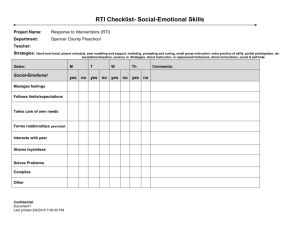Peer Relationships as Protective Factors for At
advertisement

3 FR 1-8 12/06 Abstract Peer Relationships as Protective Factors for At-Risk Children and Adolescents Prepared by: Michael M. Criss, Ph.D. Assistant Professor Department of Human Development and Family Science 322 HES; Oklahoma State University Stillwater, OK 74078 (405) 744-4325 michael.criss@okstate.edu Criss, M. M., Pettit, G. S., Bates, J. E., Dodge, K. A., & Lapp, A. L. (2002). Family adversity, positive peer relationships, and children’s externalizing behavior: A longitudinal perspective on risk and resilience. Child Development, 73, 1220-1237. Lansford, J. E., Criss, M. M., Pettit, G. S., Dodge, K. A., & Bates, J. E. (2003). Friendship quality, peer group affiliation, and peer antisocial behavior as moderators of the link between negative parenting and adolescent externalizing behavior. Journal of Research on Adolescence, 13, 161-184. IMPLICATIONS FOR COOPERATIVE EXTENSION. Although peer relationships often have been portrayed in the media as having a negative influence on children and adolescents, these two studies indicate that interactions with friends and other members of one’s peer group may provide positive benefits for at-risk youth. FCS/4-H Educators may find information from these articles helpful in understanding the value of peer relationships and the importance of identifying potential resources of support and for children and teenagers who come from disadvantaged homes. Further, this is an issue that can be emphasized through parenting education programs. Overview A number of studies have demonstrated that children and adolescents who come from homes characterized by economic disadvantage, marital conflict, and negative parenting are at risk for the development of externalizing behaviors, such as aggression and delinquency. Moreover, researchers have identified children’s peer relationships as potential protective factors or buffers for at-risk youth. In particular, some authors have argued that peer interactions may serve as remedial socialization contexts, allowing children and teens to learn important social skills not learned at home. The purpose of these two longitudinal studies was to examine peer relationships as protective factors for children and adolescents from at-risk homes. Three characteristics of peer relationships were of particular interest: Did children have friends and other peer relationships? What were the characteristics of these relationships? What were the characteristics of these peers? Method Sample. Participants in both studies were part of an on-going longitudinal project that included data from families living in Bloomington, IN and Nashville and Knoxville, TN. During the first assessment in 1987, data were collected from 585 families with preschoolers who were around 5 years old (48% female; 81% European American, 17% African American, 2% other ethnic groups; 26% single parent families). The sample was predominantly middle class, though there was considerable diversity with respect to socioeconomic status. Measures. In the study by Criss et al. (2002), three measures of family risk were assessed when the child was 5 years old: ecological risk (mother reports), marital conflict (mother and father reports), and harsh, restrictive discipline (interviewer (continued on reverse) 4 Peer Relationships as Protective Factors for At-Risk Children and Adolescents (continued) ratings). Friendship and peer group acceptance were based on sociometric interviews conducted in classrooms when the children were ages 6 and 7 years in which they were presented a list of children in their class and were asked to identify those they liked and disliked. Teachers provided information on externalizing behavior (e.g., aggression, delinquency) at age 8. In the Lansford et al. (2003) study, three measures of negative parenting were administered to parents during summer interviews when the child was 11 years old: autocratic parenting, low monitoring and supervision, and harsh, physical discipline. Children provided information on four dimensions of peer relationships in the winter when they were 12 years old: friendship quality, peer group affiliation, friend antisocial behavior, and peer group antisocial behavior. Teachers provided information on child externalizing behavior in the spring of the same year. childhood and early adolescence. It is possible that positive peer relationships may serve to ‘pick up the slack’ among youth who come from families where parents may have disengaged from their socialization responsibilities. Indeed, a number of social scientists have reported that peer relationships – which tend to be more balanced compared to the parent-child relationship – provide great opportunities for children to learn important social skills such as mutuality and reciprocity. Another possibility is that these positive peer relationships may have served as behavioral interventions for both the children and their parents. Through these positive affiliations with low antisocial peers, children may have been exposed to other families who may have served as better role models than individuals from their own home. Also, through these relationships, children’s parents may have interacted or networked with other parents and learned more effective means of disciplining their children. Results The results indicated that peer relationships in both middle childhood and early adolescence served as protective factors. That is, family adversity in early childhood was not significantly related to child externalizing behavior when children had an extensive friendship network or had good relationships with their broader peer group. These links were significant, however, when children were rejected or had few friends. Likewise, negative parenting in early adolescence was not significantly related to externalizing behavior when children had close and supportive relationships with peers, especially when the friends had low levels of antisocial behavior. That is, peer relationships only served as a protective factors when the friends were not very aggressive. Discussion Although family adversity was significantly related to externalizing behavior, these two studies showed that this association was not significant when children had positive, close, and supportive relationships with friends, especially with low antisocial peers. In other words, peer relationships served as buffers for at-risk youth in both middle (continued on reverse)








